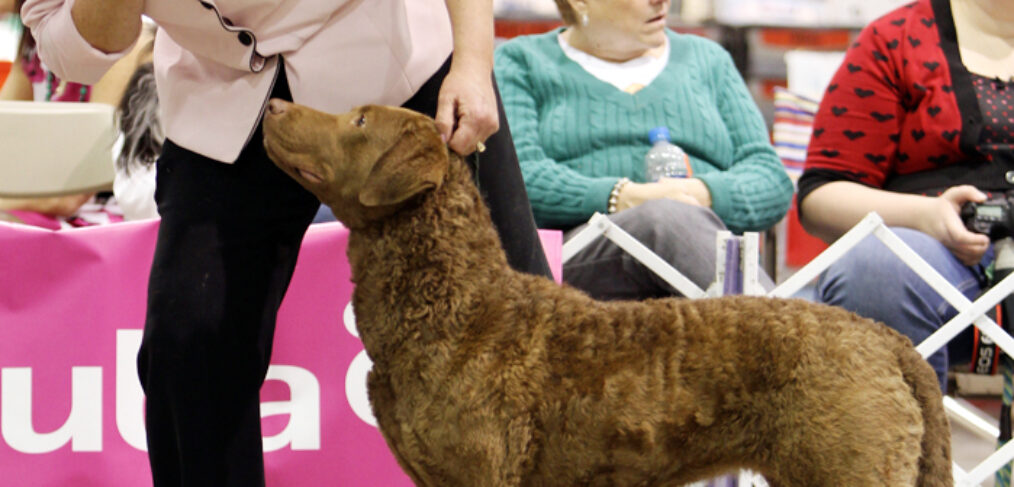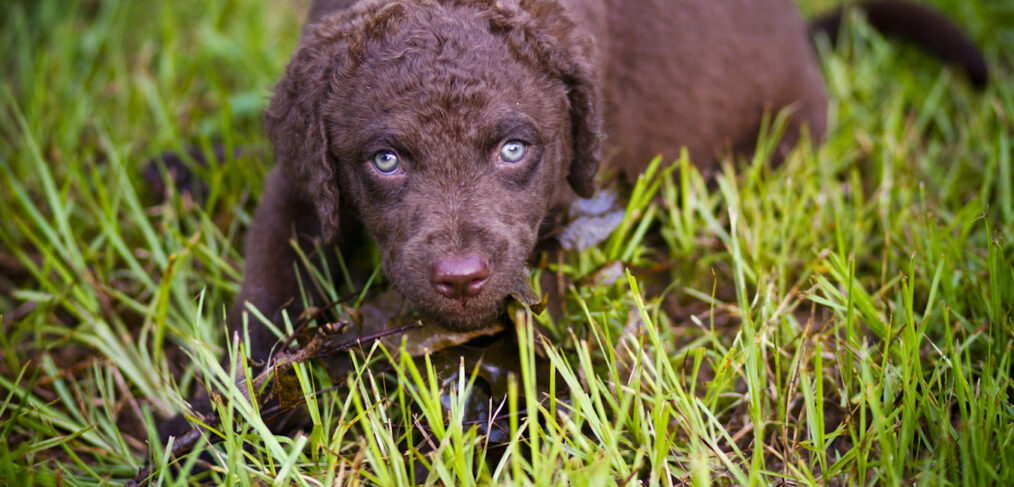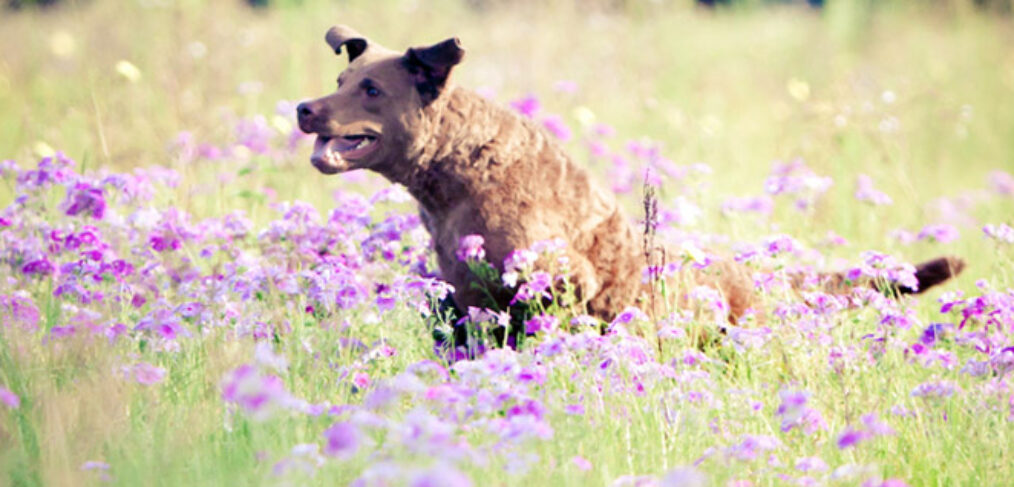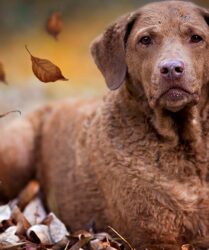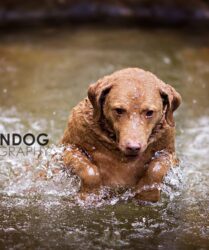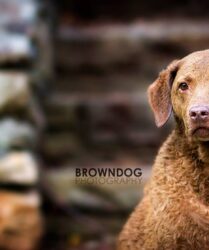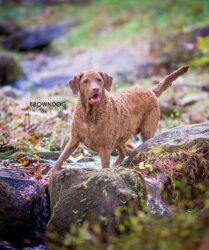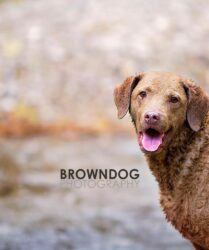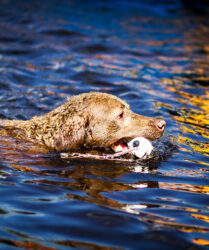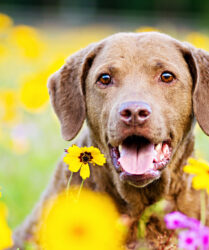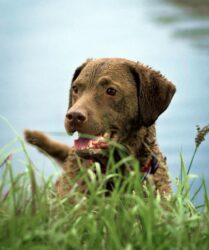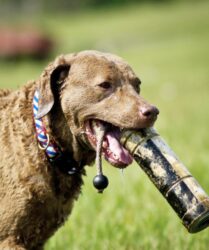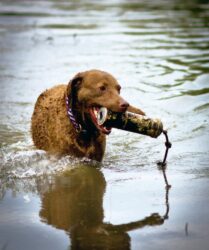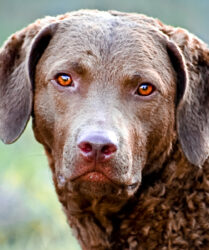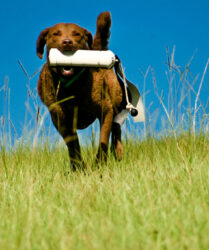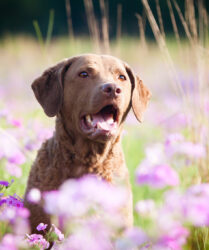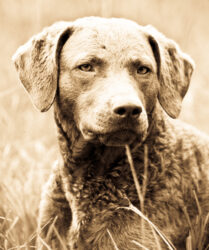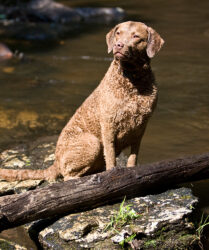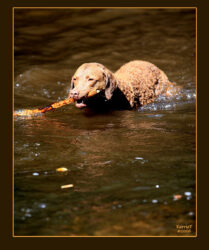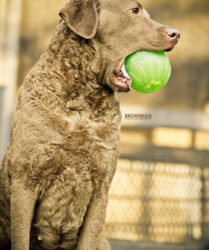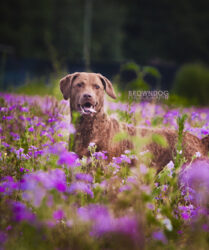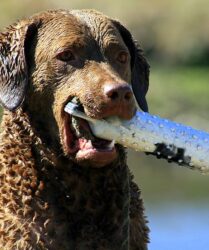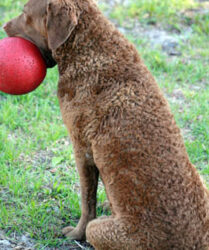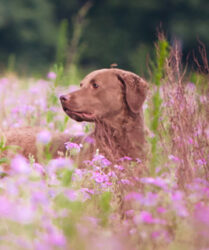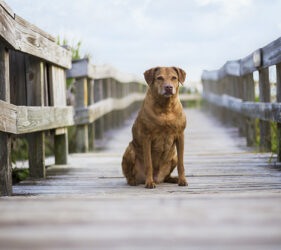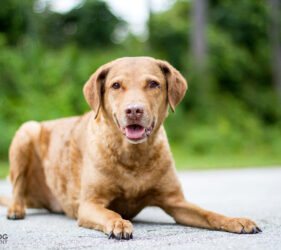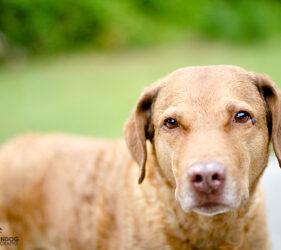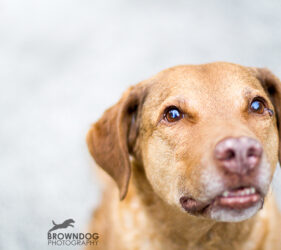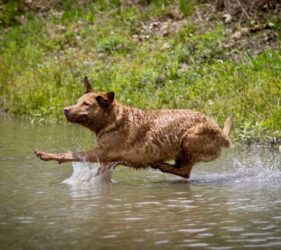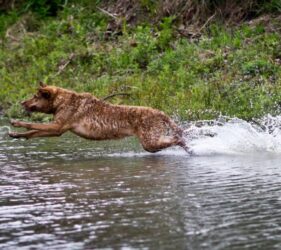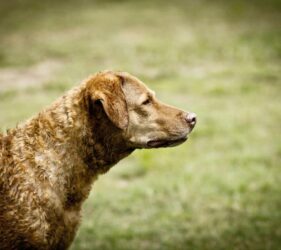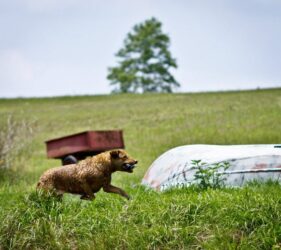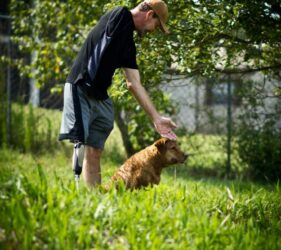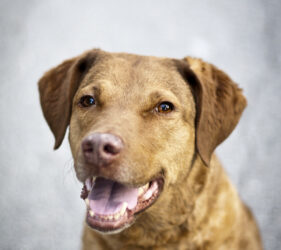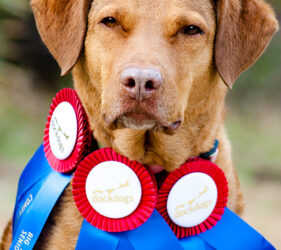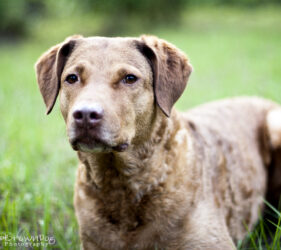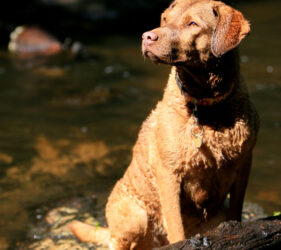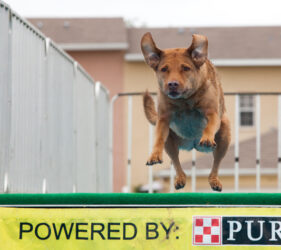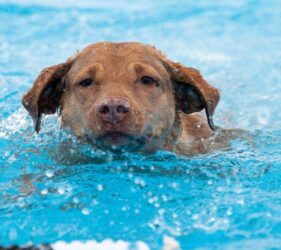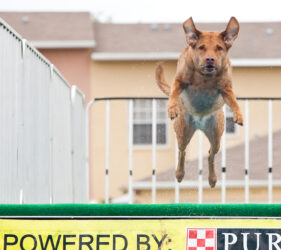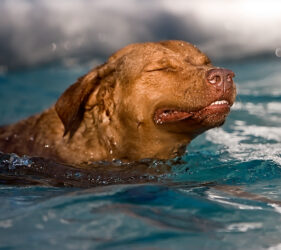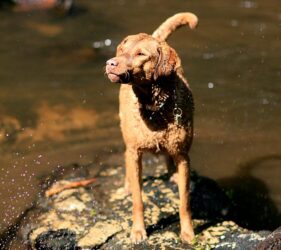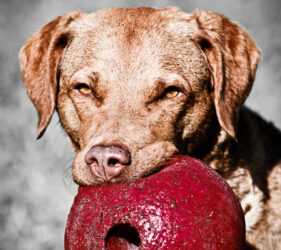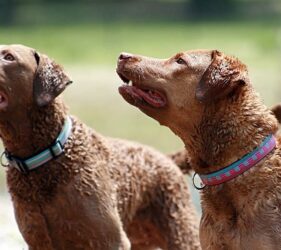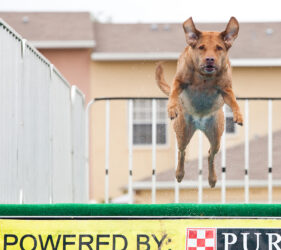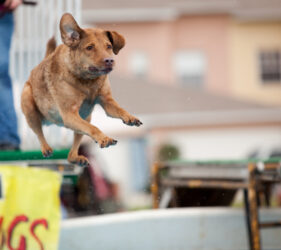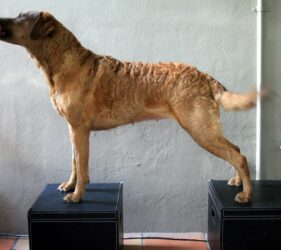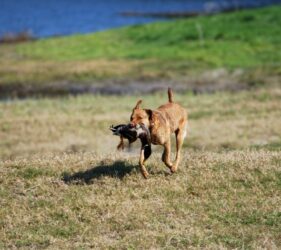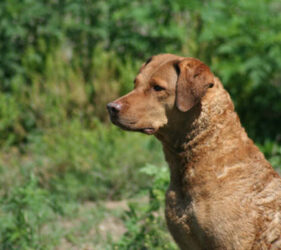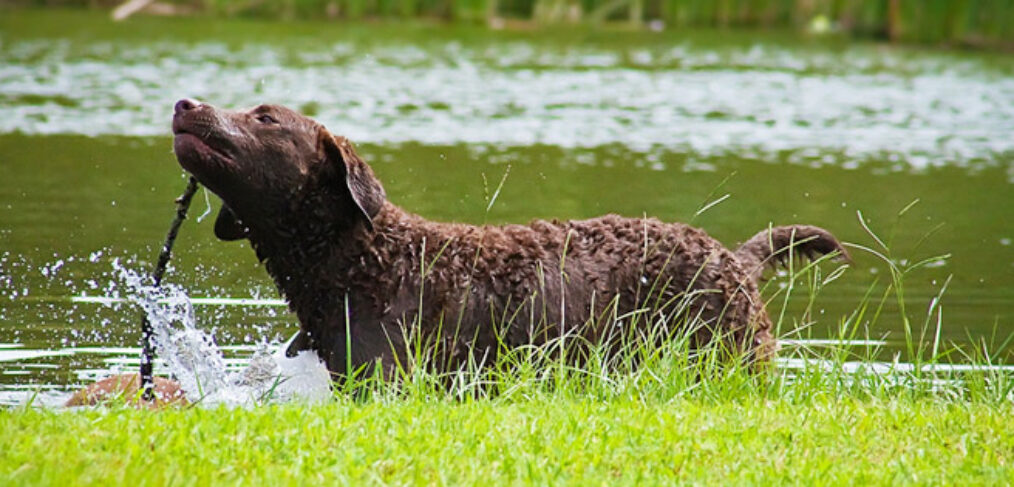It was a good weekend in York, PA. Jesse took Select Bitch on Friday. Saturday and Sunday she took Best Of Breed each day. There was a photographer there on Saturday. She got a few nice photos.
Copied and expanded upon an article by Pam Green (©1992), titled “Don’t Buy a Bouvier.”
Interested in buying a Chesapeake Bay Retriever? You must be or you wouldn’t be reading this. You’ve already heard how marvelous CBRs are. Well, I think you should also hear, before it’s too late, that
CHESAPEAKE BAY RETRIEVERS ARE NOT THE PERFECT BREED FOR EVERYONE.
As a breed they have a few features that some people find charming, but that some people find mildly unpleasant and some people find downright intolerable.
There are different breeds for different needs. There are over 200 purebred breeds of dogs in the world. Maybe you’d be better off with some other breed. Maybe you’d be better off with a cat. Maybe you’d be better off with goldfish, a parakeet, a hamster, or some house plants.
DON’T GET A CHESAPEAKE BAY RETRIEVER IF YOU…
* are attracted to the breed chiefly by its appearance
* don’t intend to educate (train) your dog
* lack leadership (self-assertive) personality
* want a totally unaggressive and unprotective dog
* are unwilling to share your house and your life with your dog
* don’t value laid-back companionship and calm affection
* are fastidious about the neatness of your home
* dislike daily physical exercise
* believe that dogs should run “free”
* can’t afford to buy, feed, and provide health care for one
* want the “latest, greatest ferocious killer attack dog”
* Don’t Buy A Chesapeake
* Don’t Buy A Chesapeake
DON’T GET A CHESAPEAKE BAY RETRIEVER if you are attracted to the breed chiefly by its appearance. From a distance, the appearance of the Chesapeakes you have seen may indicate that they are a chocolate, wavy-haired version of a Labrador Retriever. They are the largest of the retriever breeds and are not from the same lineage as a Labrador – the breedings are entirely different.
Chesapeake Bay retrievers are not related to Golden or Labrador Retrievers – and because of this very basic genetic difference, you cannot compare Chesapeakes to these breeds. Chesapeake Bay Retrievers are the result of crosses with Newfoundlands, hounds, setters, water spaniels and other dogs and were first recognized as a distinct breed in America in the middle of the 19th century. They were ducking dogs used by market hunters for retrieving waterfowl and protecting the day’s catch. These early objectives in breeding and selecting for outstanding ducking dogs has endured in today’s Chesapeakes – they are still remarkably tough working dogs and loyal, protective companions. Chesapeakes are not “happy-go lucky” retrievers – they will not “love” everyone they meet. They are indifferent to other people and dogs – very different from Goldens and Labradors. Chesapeakes are unique, intensely loyal, protective, sensitive, and serious dogs – traits that require thoughtful consideration before adopting a dog.
DON’T GET A CHESAPEAKE BAY RETRIEVER if you don’t intend to educate (train) your dog. Basic obedience and household rules training is not optional for the Chesapeake Bay Retriever. As an absolute minimum, you must teach him to reliably respond to commands to come, to lie down, to stay, and to walk at your side, on or off leash and regardless of temptations. You must also teach him to respect your household rules: e.g., is he allowed to get on the furniture? Is he allowed to beg at the table? What you allow or forbid is unimportant; but it is critical that you, not the dog, make these choices and that you enforce your rules consistently. You must commit yourself to attending an 8 to 10 week series of weekly lessons at a local obedience club or professional trainer and to doing one or two short (5 to 20 minutes) homework sessions per day. As commands are learned, they must be integrated into your daily life by being used whenever appropriate and enforced consistently.
Young Chesapeake puppies are relatively easy to train: they are eager to please, intelligent, and calm-natured, with a relatively good attention span. Once a Chesapeake has learned something, he tends to retain it well. Your cute, sweet little Chesapeake puppy will grow up to be a large, powerful dog with a highly self-assertive personality and the determination to finish whatever he starts. If he has grown up respecting you and your rules, then all his physical and mental strength will work for you. But if he has grown up without rules and guidance from you, surely he will make his own rules, and his physical and mental powers will often act in opposition to your needs and desires. For example: he may tow you down the street as if competing in a sled-dog race; he may grab food off the table; he may forbid your guests entry to his home. This training cannot be delegated to someone else, e.g., by sending the dog away to “boarding school,” because the relationship of respect and obedience is personal between the dog and the individual who does the training. This is true of all dogs to a greater or lesser degree, but definitely to a very great degree in Chesapeakes. While you definitely may want the help of an experienced trainer to teach you how to train your dog, you yourself must actually train your Chesapeake. As each lesson is well learned, then the rest of the household (except young children) must also work with the dog, insisting he obey them as well.
Many of the Chesapeakes that are rescued from pounds and shelters show clearly that they have received little or no basic training, neither in obedience nor in household deportment; yet these same dogs respond well to such training by the rescuer or the adopter. It seems likely that a failure to train the dog is a significant cause of CBR abandonment. If you don’t intend to educate your dog, preferably during puppyhood, you would be better off with a breed that is both small and socially submissive, e.g., a Shetland Sheepdog. Such a dog does require training, but a little bit goes further than with a Chesapeake. Chesapeakes can, with adequate training, excel at such working competitions as field trials and hunt tests, obedience, agility, and tracking.
DON’T BUY A CHESAPEAKE BAY RETRIEVER if you lack leadership (self-assertive) personality. Dogs do not believe in social equality. They live in a social hierarchy led by a pack-leader (Alpha). The alpha dog is generally benevolent, affectionate, and non-bullying towards his subordinates; but there is never any doubt in his mind or in theirs that the alpha is the boss and makes the rules. Whatever the breed, if you do not assume the leadership, the dog will do so sooner or later, and with more or less unpleasant consequences for the abdicating owner. Like the untrained dog, the pack leader dog makes his own rules and enforces them against other members of the household by means of a dominant physical posture and a hard-eyed stare, followed by a snarl, then a knockdown blow or a bite. Breeds differ in tendencies towards social dominance; and individuals within a breed differ considerably.
Chesapeakes as a breed tend to be of a socially dominant personality. You really cannot afford to let a Chesapeake become your boss. You do not have to have the personality or mannerisms of a Marine boot camp Sergeant, but you do have to have the calm, quiet self-assurance and self assertion of the successful parent (“Because I’m your mother, that’s why.”) or successful grade-school teacher. If you think you might have difficulty asserting yourself calmly and confidently to exercise leadership, then choose a breed known for its socially subordinate disposition, such as a Golden Retriever or a Shetland Sheepdog, and be sure to ask the breeder to select one of the more submissive pups in the litter for you. If the whole idea of “being the boss” frightens or repels you, don’t get a dog at all. Cats don’t expect leadership. A caged bird or hamster, or fish doesn’t need leadership or household rules. Leadership and training are inextricably intertwined: leadership personality enables you to train your dog, and being trained by you reinforces your dog’s perception of you as the alpha.
DON’T BUY A CHESAPEAKE BAY RETRIEVER if you want a totally unaggressive and unprotective dog. Most Chesapeakes have an assertive and confident personality. When confronted with a threat, a proper Chesapeake Bay Retriever will be somewhat more ready to fight than to flee. Thus he may respond aggressively in situations where many other breeds back down. Most Chesapeakes have some inclination to act aggressively to repel intruders on their territory (i.e.,your home) and to counteract assaults upon their packmates (you and your family). Without training and leadership from you to guide him, the dog cannot judge correctly whom to repel and whom to tolerate. Without training and leadership, sooner or later he may injure an innocent person who will successfully sue you for more than you own. With good training and leadership from you, he can be profoundly valuable as a defender of your home and family. (See also remarks on stability and socialization below.)
If you feel no need of an assertive dog, if you are embarrassed by a barking dog at your door, or if you have the slightest doubts of your ability and willingness to supply the essential socialization, training and leadership, then please choose one of the many breeds noted for thoroughly unaggressive temperament, such as a Sheltie or a Golden Retriever.
DON’T GET A CHESAPEAKE BAY RETRIEVER if you are unwilling to share your house and your life with your dog. Chesapeakes were bred to share in the work of the family and to spend most of their waking hours working with the family. They thrive on companionship and they want to be wherever you are. They are happiest living with you in your house and going with you when you go out. While they usually tolerate being left at home by themselves, they should not be relegated to the backyard or kennel. A puppy exiled from the house is likely to grow up to be unsociable (fearful and/or unprovokedly aggressive), unruly, and unhappy. He may well develop pastimes, such as digging or barking, that will displease you and/or your neighbors. An adult so exiled will be miserable too. If you don’t strongly prefer to have your dog’s companionship as much as possible, enjoying having him sleep in your bedroom at night and sharing many of your activities by day, you should choose a breed less oriented to human companionship. Likewise, if your job or other obligations prevent you from spending much time with your dog. No dog is really happy without companionship, but the pack hounds are more tolerant of being kenneled or yarded so long as it is in groups of 2 or more. A better choice would be a cat, as they are solitary by nature.
DON’T GET A CHESAPEAKE BAY RETRIEVER if you don’t value laid-back companionship and calm affection. A Chesapeake becomes deeply attached and devoted to his own family, but he doesn’t “wear his heart on his sleeve.” Some are noticeably reserved, others are more outgoing, but few adults are usually exuberantly demonstrative of their affection. They make remarkable eye contact with their favorite people. They like to be near you, usually in the same room, preferably on a comfortable pad or cushion in a corner or under a table, just “keeping you company.” They enjoy conversation, petting and cuddling when you offer it, but they are moderate and not overbearing in coming to you to demand much attention. They are emotionally sensitive to their favorite people: when you are joyful, proud, angry, or grief-stricken, your Chesapeake will immediately perceive it and will believe himself to be the cause. The relationship can be one of great mellowness, depth and subtlety; it is a relation on an adult-to-adult level, although certainly not one devoid of playfulness – Chesapeakes are famous for their vocalization with their people (the “roo-roo-roos” and the snorts). As puppies, of course, they will be more dependent, more playful, and more demonstrative. In summary, Chesapeakes tend to be sober and thoughtful, rather than giddy clowns or synchophants. A number of breeds retain into adulthood a more puppyish and playful disposition, e.g., Australian Shepherds, Malamutes, and others. Quite a few are far more dramatically demonstrative and/or more clingingly dependent, e.g., the Golden Retriever.
DON’T GET A CHESAPEAKE BAY RETRIEVER if you are fastidious about the neatness of your home. The Chesapeake’s unique, water-repellent coat and his love of playing in water combine to make him a highly efficient transporter of dirt into your home, depositing same on your floors and rugs and possibly also on your furniture and clothes. You must realize that you should be prepared to get wet when you and your Chesapeake are near water. Although it is technically true that Chesapeake do not shed long coats and do not require professional grooming, they do “blow coat” at least twice a year and your house will be full of brown “dust bunnies” tumbleweeding their way about your house. I don’t mean to imply that you must be a slob or slattern to live happily with a Chesapeake, but you do have to have the attitude that your dog’s company means more to you than does neatness and you do have to be comfortable with a less than immaculate house. All dogs, like all children, create a greater or lesser degree of household mess. The Basenji is perhaps the cleanest, due to its cat-like habits; but cats are cleaner yet, and goldfish hardly ever mess up the house.
DON’T GET A CHESAPEAKE BAY RETRIEVER if you dislike daily physical exercise. Chesapeakes need exercise to maintain the health of heart and lungs and to maintain muscle tone. An adult Chesapeake should have a morning outing of a mile or more, as you walk briskly, jog, or bicycle beside him, and a similar evening outing. For puppies, shorter and slower walks, several times a day are preferred for exercise and housebreaking. But, more than just walks, you need to “work” your Chesapeake. Chesapeakes were bred to work hard and the modern dogs still thrive on work. Anyone who owns one should be able to devote at least 20 minutes a day either working, training, retrieving or playing with them. Chesapeakes that are not worked – both physically and mentally – are prone to mischief and will not “think.” Because of their love of water, 20 minutes of water retrieves is usually much more intense work than an hour walking around the neighborhood nicely on the leash. These active, intelligent dogs need jobs and responsibilities – it is best if you designate what these jobs are – you might not agree with what your Chesapeake decides is important!
All dogs need daily exercise of greater or lesser length and vigor. If providing this exercise and work is beyond you, physically or temperamentally, then choose one of the many small and energetic breeds that can exercise itself within your fenced yard. Most of the Toys and Terriers fit this description, but don’t be surprised if a Terrier is inclined to dig in the earth since digging out critters is the job that they were bred to do. Cats can be exercised indoors with mouse-on-a-string toys. Hamsters will exercise themselves on a wire wheel. House plants don’t need exercise.
DON’T GET A CHESAPEAKE BAY RETRIEVER if you believe that dogs should run “free.” Whether you live in town or country, no dog can safely be left to run “free” outside your fenced property and without your direct supervision and control. The price of such “freedom” is inevitably injury or death: from dogfights, from automobiles, from the Pound or from justifiably irate neighbors. Even though Chesapeakes are home-loving and less inclined to roam than most breeds, an unfenced Chesapeake is destined for disaster. The unfenced city Chesapeake is likely to exercise his inherited retrieving instinct on joggers, bicyclists, and automobiles. A thoroughly obedience-trained Chesapeake Bay Retriever can enjoy the limited and supervised freedom of off-leash walks with you in appropriately chosen environments. If you don’t want the responsibility of confining and supervising your pet, then no breed of dog is suitable for you. A neutered cat will survive such irresponsibly given “freedom” somewhat longer than a dog, but will eventually come to grief. A better answer for those who crave a “free” pet is to set out feeding stations for some of the indigenous wildlife, such as raccoons, which will visit for handouts and which may eventually tolerate your close observation.
DON’T GET A CHESAPEAKE BAY RETRIEVER if you can’t afford to buy, feed, and provide health care for one. Chesapeakes are not a cheap breed to buy, as running a careful breeding program with due regard for temperament, trainability, and physical soundness (hips & eyes especially) cannot be done cheaply. The time the breeder should put into each puppy’s “pre-school” and socialization is also costly. The “bargain” puppy from a “back-yard breeder” who unselectively mates any two Chesapeakes who happen to be of opposite sex may well prove to be extremely costly in terms of bad temperament, bad health, and lack of essential socialization. In contrast, the occasional adult or older pup is available at modest price from a disenchanted owner or from a breeder, shelter, or rescuer to whom the dog was abandoned; most of these “used” Chesapeakes are capable of becoming a marvelous dog for you if you can provide training, leadership, and understanding. Whatever the initial cost of your Chesapeake, the upkeep will not be cheap.
Being large dogs, Chesapeakes eat relatively large meals. (Need I add that what goes in one end must eventually come out the other?) Large dogs tend to have larger veterinary bills, as the amount of anesthesia and of most medications is proportional to body weight. Spaying or neutering, which costs more for larger dogs, is an essential expense for virtually all pet Chesapeakes, as it “takes the worry out of being close”, prevents serious health problems in later life, and makes the dog a more pleasant companion. Chesapeakes are subject to hip dysplasia which can be costly to treat. (Your best insurance against dysplasia is to buy only from a litter bred from OFA-certified parents and (if possible), grandparents. Yes, this generally means paying more. Finally, the modest fee for participation in a series of basic obedience training classes is an essential investment in harmonious living with your dog; such fees are the same for all breeds, although conceivably you will need to travel a bit further from home to find a training class teacher who is competent with the more formidable breeds, such as the Chesapeake. The modest annual outlays for immunizations and for local licensing are generally the same for all breeds, although some counties have a lower license fee for spayed/neutered dogs. All dogs, of whatever breed and however cheaply acquired, require significant upkeep costs, and all are subject to highly expensive veterinary emergencies. Likewise all cats.
DON’T GET A CHESAPEAKE BAY RETRIEVER if you want the “latest, greatest ferocious killer attack dog”. Although the Chesapeake has been bred to be protective of his owner’s home, and he may be described as the “Rottweiler of the retrievers,” the Chesapeake is less capable in these respects than half a dozen other protection breeds. Chesapeakes must have great respect for the leadership of his handler and must be solidly trained in basic obedience to that handler. Equally essential, he must have a rock-solidly stable temperament and he must also have been “socialized” out in the world enough to know that most people are friendly and harmless, so that he can later learn to distinguish the bad guys from the good guys. Please don’t buy any dog for protection training unless you are absolutely committed to the extreme amount of work that will be required of you personally. Also talk to your lawyer and your insurance agent first. In contrast to the protection-trained dog, trained to bite on direct command or in reaction to direct physical assault on his master, the “deterrent dog” dissuades the vast majority of aspiring burglars, rapists, and assailants by his presence, his appearance, and his demeanor. Seeing such a dog, the potential wrong-doer simply decides to look for a safer victim elsewhere. For this job, all that is needed is a dog that is large and that appears to be well-trained and unafraid. Chesapeake’s are suited to this type of protection, since they usually bark at people who approach the property or the home. On a leash, however, most people equate the Chesapeake with the Labrador, a notoriously friendly dog.
Other breeds of dog which are suitable for protection or for deterrence include the Doberman, Rottweiler, German Shepherd, Briard, Belgian Sheepdog, Belgian Tervuren, and Belgian Malinois. Of these the first 3 are recognized by the general public as “police dogs” and are probably far more feared by most potential criminals would be by a Chesapeake. The Malamute, though not suitable for protection, is quite effective for deterrence due to his highly wolf-like appearance.
DON’T GET A CHESAPEAKE BAY RETRIEVER if you are not willing to commit yourself for the dog’s entire lifetime. No dog deserves to be cast out because his owners want to move to a no-pet apartment or because he is no longer a cute puppy or didn’t grow up to be a beauty contest winner or because his owners through lack of leadership and training have allowed him to become an unruly juvenile delinquent with a repertoire of undesirable behaviors. The prospects of a responsible and affectionate second home for a “used” dog are never very bright, but they are especially dim for a large, poorly mannered dog. A Chesapeake dumped into a Pound or Shelter has almost no chance of survival unless he has the great good fortune to be spotted by someone dedicated to Chesapeake Bay Retriever Rescue. The prospects for adoption for a youngish, well-trained, Chesapeake whose owner seeks the assistance of the nearest Chesapeake Club or Rescue group are fairly good; but an older Chesapeake has diminishing prospects. Be sure to contact your local American Chesapeake breeder or Rescue group if you are diagnosed as terminally ill or have other equally valid reason for seeking an adoptive home. Be sure to contact your local Chesapeake breeder or rescuer if you are beginning to have difficulties in training your Chesapeake, so these can be resolved. Be sure to make arrangements in your will or with your family to ensure continued care or adoptive home for your Chesapeake if you should pre-decease him.
The life span of a Chesapeake Bay Retriever is from 10 to 15 years. If that seems too long a time for you to give an unequivocal loyalty to your Chesapeake, then please do not get one! Indeed, as most dogs have a life expectancy that is as long or longer, please do not get any dog!
IN CONCLUSION
If all the preceding “bad news” about Chesapeake hasn’t turned you away from the breed, then by all means DO GET A CHESAPEAKE BAY RETRIEVER! They are every bit as wonderful as you have heard!
If buying a puppy, be sure to shop carefully for a responsible and knowledgeable breeder who places high priority on breeding for sound temperament and trainability and good health in all matings. Such a breeder will interrogate and educate potential buyers carefully. Such a breeder will continue to be available for advice and consultation for the rest of the puppy’s life and will insist on receiving the dog back if ever you are unable to keep it.
CoolWater Chesapeakes
For the Love of the Chesapeake Bay Retriever
The Chesapeake Bay Retriever
Sherman tank of water dogs.
Tough and tenacious, the Chesapeake Bay Retriever is a serious hunting dog developed to withstand the brutally cold, rough waters of the Eastern Seaboard, in particular, the Chesapeake Bay where he was bred by hunters in need of a dog to hunt all day and then some. The Chessie is one of the relatively few breeds completely “Made in America.”
What Others Have to Say

CH Silvercreek’s Spiced Rum
Morgan is the matriarch here at 11 1/2 years of age. She’s a medium brown in color and right in the middle of the Chesapeake standard at about 23″ to the shoulder and 65-70 lbs. She’s a nice size and isn’t overly done in any respect. She has a fabulous harsh coat that is very brillo like in feel and like her mother, she has fabulous movement which appears effortless. Morgan’s handlers often comment on how wonderful she is to show as she simply glides around the ring.
Morgan is very easy to live with. Like most Chesapeakes, Morgan is a wonderful marker and has great drive with a strong desire to retrieve and swim. She will often nudge you to throw a ball or bumper for her just one more time — she’d go all day long if you’d let her. She gets along well with other dogs but can be a little reserved with people she doesn’t know.
In 2007, Morgan took 2nd place in the Open Bitch class at the Chessie National Show Specialty in Colorado Springs, CO. In February 2008, she obtained her Champion title under judge Mr. Richard L. Bauer. In the end, she took Best of Breed over multiple male specials earning herself a 5 point major.
We often call Morgan “Wiggle, Wiggle” because when she’s happy her whole body just wiggles with excitement.
OFA- Good: CB-8914G26F-VPI
Cardiac – Normal: CB-CA58/26F/P-VPI
Elbow – Normal: CB-EL1284F26-VPI
Thyroid – Normal: CB-TH66/26F-VPI
PRA: A
DM: N/N – Clear/Normal
|
Cabinridge’s Crack Me A Bud |
|
| CH Chesabar’s Mt N Bruiser CD, JH | CH Chesbar’s Star of Obadiahs |
| CH Chesabar’s Brittany | |
| CH Cabinridge’s Favorite Fergie | CH CHes-Shores Crazy As A Loon |
| CH Cabinridge’s Glowing Amber | |
|
BISS Am/Can CH*Silvercreek Casbar’s Cheers |
|
| BIS Am/Can CH* Silvercreek Remington Steele JH, WD | CH Pond Hollow Calico Key Largo |
| Am/Can/PR/World CH* Silvercreek I Love Lucy JH, WD, CGC/TDI ROMQ | |
| Mattamuskeet’s Diamond Maggie G | CH Sand Bar’s Cast In Stone |
| CH Mattamuskeet Lady of the Lake |

-
SHR Jessie’s On Her Way CD, JH
To know Jessie is to love Jessie — that’s what everyone says. She is happy-go-lucky, takes everything in stride and is happiest when working in the field but she adapts well to home-life.
Her willingness to please and eagerness to learn makes her fun to train — a little praise does wonders and really keeps her up, up, up. She’s a busy dog that often needs a job to do. She’s very inquisitive and if you don’t have a job for her, she will often find one on her own.
Jessie loves to talk, and although she doesn’t ‘roo’ as many Chessie do, she does smile and will often give a full-Chessie grin when she’s happy to see you.
Jessie obtained her AKC Junior Hunter (JH) and UKC Started Hunting Retriever (SHR) titles with qualifying passes each time she ran — all within a two month span and with very limited training. She also easily obtained her AKC Obedience Companion Dog (CD) title.
In 2008, Jessie was bred with CH Pondhollow BroadWater Bear SH. This breeding resulted in two puppies – a male (Risk, which we kept) and a female (Noelle, who went to LongCove Chesapeakes in GA).
I once mentioned to a good friend, a field trainer, “if I ever get another dog like Jessie…” He paused, looked at me and said “There will never be another dog like Jessie. Jessie is special.” I tend to agree. I doubt I’ll ever have another quite like her.
Elbows: Normal CB-EL1067F47-PI
Hips: Good CB-8520G47F-PI
Cardiac: Normal CB-CA43/47F/P-PI
PRA: Clear/Normal
DM: At Risk
SHR Jessie’s On Her way CD, JH |
Cajun Breaux | CH* Chesagrove’s KodiakSport CD, MH, WDQ | CH Eastern Waters The Equalizer |
| CH Pinebrook Chesagrove Carrie CDX, JH | |||
| Lakebreeze’s Caddyshack JH | FC/AFC Ed’s Turnpike Drifter MH*** | ||
| Lakebreeze’s Ginger Ale | |||
| Cajun Bayou Queen | ****DC/AFC Coot’s Gypsy Clipper MH*** ROMQ | Captain Cody’s Coot Catcher MH, WDQ***c | |
| CH Chip’s Gypsy of Caroway WD | |||
| Eastin’s Brown Starr Catcher | Magnum DI | ||
| Falcon’s Candy Can |
Chesapeake Bay Retriever Breed Standard
Sporting Group
General Appearance
Equally proficient on land and in the water, the Chesapeake Bay Retriever was developed along the Chesapeake Bay to hunt waterfowl under the most adverse weather and water conditions, often having to break ice during the course of many strenuous multiple retrieves. Frequently the Chesapeake must face wind, tide and long cold swims in its work. The breed’s characteristics are specifically suited to enable the Chesapeake to function with ease, efficiency and endurance. In head, the Chesapeake’s skull is broad and round with a medium stop. The jaws should be of sufficient length and strength to carry large game birds with an easy, tender hold. The double coat consists of a short, harsh, wavy outer coat and a dense, fine, wooly undercoat containing an abundance of natural oil and is ideally suited for the icy rugged conditions of weather the Chesapeake often works in. In body, the Chesapeake is a strong, well-balanced, powerfully built animal of moderate size and medium length in body and leg, deep and wide in chest, the shoulders built with full liberty of movement, and with no tendency to weakness in any feature, particularly the rear. The power though, should not be at the expense of agility or stamina. Size and substance should not be excessive as this is a working retriever of an active nature.
Distinctive features include eyes that are very clear, of yellowish or amber hue, hindquarters as high or a trifle higher than the shoulders, and a double coat which tends to wave on shoulders, neck, back and loins only.
The Chesapeake is valued for its bright and happy disposition, intelligence, quiet good sense, and affectionate protective nature. Extreme shyness or extreme aggressive tendencies are not desirable in the breed either as a gun dog or companion.
Disqualifications: Specimens that are lacking in breed characteristics should be disqualified.
Size, Proportion, Substance
Height–Males should measure 23 to 26 inches; females should measure 21 to 24 inches. Oversized or undersized animals are to be severely penalized. Proportion–Height from the top of the shoulder blades to the ground should be slightly less than the body length from the breastbone to the point of buttocks. Depth of body should extend at least to the elbow. Shoulder to elbow and elbow to ground should be equal. Weight–Males should weigh 65 to 80 pounds; females should weigh 55 to 70 pounds.
Head
The Chesapeake Bay Retriever should have an intelligent expression. Eyes are to be medium large, very clear, of yellowish or amber color and wide apart. Ears are to be small, set well up on the head, hanging loosely, and of medium leather. Skull is broad and round with a medium stop. Nose is medium short. Muzzle is approximately the same length as the skull, tapered, pointed but not sharp. Lips are thin, not pendulous. Bite–Scissors is preferred, but a level bite is acceptable.
Disqualifications: Either undershot or overshot bites are to be disqualified.
Neck, Topline, Body
Neck should be of medium length with a strong muscular appearance, tapering to the shoulders. Topline should show the hindquarters to be as high as or a trifle higher than the shoulders. Back should be short, well coupled and powerful. Chest should be strong, deep and wide. Rib cage barrel round and deep. Body is of medium length, neither cobby nor roached, but rather approaching hollowness from underneath as the flanks should be well tucked up. Tail of medium length; medium heavy at the base. The tail should be straight or slightly curved and should not curl over back or side kink.
Forequarters
There should be no tendency to weakness in the forequarters. Shoulders should be sloping with full liberty of action, plenty of power and without any restrictions of movement. Legs should be medium in length and straight, showing good bone and muscle. Pasterns slightly bent and of medium length. The front legs should appear straight when viewed from front or rear. Dewclaws on the forelegs may be removed. Well webbed hare feet should be of good size with toes well-rounded and close.
Hindquarters
Good hindquarters are essential. They should show fully as much power as the forequarters. There should be no tendency to weakness in the hindquarters. Hindquarters should be especially powerful to supply the driving power for swimming. Legs should be medium length and straight, showing good bone and muscle. Stifles should be well angulated. The distance from hock to ground should be of medium length. The hind legs should look straight when viewed from the front or rear. Dewclaws, if any, must be removed from the hind legs.
Disqualifications: Dewclaws on the hind legs are a disqualification.
Coat
Coat should be thick and short, nowhere over 1½ inches long, with a dense fine wooly undercoat. Hair on the face and legs should be very short and straight with a tendency to wave on the shoulders, neck, back and loins only. Moderate feathering on rear of hindquarters and tail is permissible.
The texture of the Chesapeake’s coat is very important, as the Chesapeake is used for hunting under all sorts of adverse weather conditions, often working in ice and snow. The oil in the harsh outer coat and wooly undercoat is of extreme value in preventing the cold water from reaching the Chesapeake’s skin and aids in quick drying. A Chesapeake’s coat should resist the water in the same way that a duck’s feathers do. When the Chesapeake leaves the water and shakes, the coat should not hold water at all, being merely moist.
Disqualifications: A coat that is curly or has a tendency to curl all over the body must be disqualified. Feathering on the tail or legs over 1¾ inches long must be disqualified.
Color
The color of the Chesapeake Bay Retriever must be as nearly that of its working surroundings as possible. Any color of brown, sedge or deadgrass is acceptable, self-colored Chesapeakes being preferred. One color is not to be preferred over another. A white spot on the breast, belly, toes, or back of the feet (immediately above the large pad) is permissible, but the smaller the spot the better, solid colored preferred. The color of the coat and its texture must be given every consideration when judging on the bench or in the ring. Honorable scars are not to be penalized.
Disqualifications: Black colored; white on any part of the body except breast, belly, toes, or back of feet must be disqualified
Gait
The gait should be smooth, free and effortless, giving the impression of great power and strength. When viewed from the side, there should be good reach with no restrictions of movement in the front and plenty of drive in the rear, with good flexion of the stifle and hock joints. Coming at you, there should be no sign of elbows being out. When the Chesapeake is moving away from you, there should be no sign of cowhockness from the rear. As speed increases, the feet tend to converge toward a center line of gravity.
Temperament
The Chesapeake Bay Retriever should show a bright and happy disposition with an intelligent expression. Courage, willingness to work, alertness, nose, intelligence, love of water, general quality and, most of all, disposition should be given primary consideration in the selection and breeding of the Chesapeake Bay Retriever.
Disqualifications:
1. Specimens lacking in breed characteristics.
2. Teeth overshot or undershot.
3. Dewclaws on the hind legs.
4. Coat curly or with a tendency to curl all over the body.
5. Feathering on the tail or legs over 1¾ inches long.
6. Black colored.
7. White on any part of the body except breast, belly, toes, or back of feet.
The question of coat and general type of balance takes precedence over any scoring table which could be drawn up. The Chesapeake should be well proportioned, an animal with a good coat and well balanced in other points being preferable to one excelling in some but weak in others.
Positive Scale of Points
| Head, including lips, ears and eyes | 16 |
| Neck | 4 |
| Shoulders and body | 12 |
| Hindquarters and stifles | 12 |
| Elbows, legs and feet | 12 |
| Color | 4 |
| Stern and tail | 10 |
| Coat and texture | 18 |
| General conformation | 12 |
| Total | 100 |
| Approximate Measurements | Inches |
| Length head, nose to occiput |
9½ to 10
|
| Girth at ears |
20 to 21
|
| Muzzle below eyes |
10 to 10½
|
| Length of ears |
4½ to 5
|
| Width between eyes |
2½ to 2¾
|
| Girth neck close to shoulder |
20 to 22
|
| Girth at flank |
24 to 25
|
| Length from occiput to tail base |
34 to 35
|
| Girth forearms at shoulders |
10 to 10½
|
| Girth upper thigh |
19 to 20
|
| From root to root of ear, over skull |
5 to 6
|
| Occiput to top shoulder blades |
9 to 9½
|
| From elbow to elbow over the shoulders |
25 to 26
|
Approved November 9, 1993
Effective December 31, 1993
What is PRA?
Below are extracted pieces of the article, Breeders Ask Optigen… The Whys and Wherefores of Testing Your Dog for PRA by Mary M. Woodsen. For the purpose of this Web site, it has been condensed and updated for Chesapeake Bay Retrievers.
Chesapeake Bay Retrievers gained access to the first genetic test in 1998. The test is by OptiGen and it detects prcd-PRA (Progressive Retinal Atrophy) in CBRs. The test is now in its third rendition.
What is PRA? Is there any way to treat it? Can I prevent it?
Progressive Retinal Atrophy (PRA–and specifically, the prcd form of PRA) is an inherited eye disease that affects not only Chesapeake Bay Retrievers but several other breeds as well. Dogs with prcd-PRA, over time, go blind.
In most breeds PRA is evident by the time a dog is at least six years old, after it has already been bred. In order to develop PRA, a dog must inherit two copies of the defective prcd-PRA gene: one from its dam, one from its sire. There’s no cure, no treatment; no way to stop it.PRA, however, can be prevented in the next generation even though you can’t treat it in the current generation. Through safe, selective breeding based on a simple DNA test.
Marker-based genetic testing.
There are two general types of marker tests used in genetic testing, and sometimes they’re confused. Our’s is a marker (linkage) test with No Chance of Recombination. This means that the marker is close enough to the gene that its chance of splitting away from that gene during meiosis (sexual reproduction) and skewing the test is less than one in several billion! (Some types of marker [linkage] tests do allow for recombination, which means that the test can give either false positive or false negative results. In other words, a small percentage of dogs that test as genetic normals could actually be a carrier or affected, and visa versa.)
This test, in fact, designates a dog as genetically normal (clear) with absolute, unequivocal, totally reliable, 100%-no-ifs-ands-or-buts accuracy. And that’s good news, because you can take your otherwise really great dog that happens to test as (probable) carrier or (probable) affected and breed it to a certified (no ifs ands or buts) normal–and know that no pup will ever be affected.
What does “probable” carrier and “probable” affected mean?
The problem with markers is this: way back when the first pup was born with a mutated gene, the gene’s marker didn’t mutate too. Indeed, that pup was the very first carrier. Of course, it still had its parents’ other healthy gene, and passed one or the other of the pair along to each of its pups. Today, dogs testing as carriers and affecteds either carry that ancestral pup’s damaged gene-plus-marker–or they carry that pup’s parent’s normal gene-plus-marker. But which gene, which marker? We can’t tell–we haven’t found the gene yet, and the markers look just alike. We call this look-alike marker a false allele.
This ancestral, normal gene-plus-marker–the false allele–is the wild card. Thus a dog may test as Pattern B (probable carrier) yet carry two normal genes, one of which has those look-alike markers. Likewise a probable affected–a Pattern C dog–may carry one damaged and one normal gene–or less likely, two normal genes. That’s why we use the designations “Pattern B” and “Pattern C”: because some Bs aren’t carriers and some Cs aren’t affected.
The marker for Pattern A has never accompanied a mutated gene and thus could never have a false allele.
Explain, please, what an allele is.
Alleles (say it a-lee-el) are different versions of the same gene. Does your sister have brown eyes, your brother hazel eyes, but yours are blue? In humans, eye color is caused by different alleles of the “eye-color gene.” (Eye color is a bit more complex in dogs.) In the same way, genes for retinal functioning have different forms, or alleles, and the defective gene is one. In fact, even markers have alleles. One of those alleles always accompanies the mutated gene, but in its ancestral form, it sometimes accompanies the normal gene.
How can you offer a test if it isn’t accurate?
Our definition of “accuracy” has to do with the detection of the markers used in the laboratory. The OptiGen test for the markers of PRA is exactly accurate. This means that the test gives clear readings in the laboratory; there is no issue of interpreting what we see–no false positive. (A false allele result is not a false positive result.) Numerous controls–absolute measures of accuracy–are used for every sample we process. The results for every dog will never change with age and will be the same whenever this current test is repeated. (In contrast, a false positive reading can change.) Pattern A dogs will always test as Pattern A. Likewise, Bs will always be Bs and Cs will always be Cs. These are lifetime guarantees–and they are accurate. As scientists we are necessarily bound to this definition of accuracy, and could not state it differently.
So a C dog can be normal, clear?
Yes, that’s possible, if it has two false alleles–two look-alike markers. Then sure, it’s actually normal, but this genetic test can’t prove it normal. It may indeed be normal but the best you dare guess, if you have a normal ERG and the dog is over six years old, is that it’s a carrier. You still need to breed it with caution to certified clears. Don’t worry – within a couple generations you can breed completely clear progeny.
Given that a dog comes back as a B or a C, what is the next best course to follow to determine its true genetic status? Should we test its parents, or perhaps its offspring or grandchildren? How do we find out if the dog really has a false allele and what do we do about it?
The markers to the prcd gene are inherited, just as is the prcd gene itself. If the look-alike false allele is involved in one dog, it will be passed from one generation to the next. Which means that testing parents, offspring or grandpups won’t help you figure out that a false allele is involved. If a dog is Pattern C (probable affected) and is bred to an A (no ifs ands or buts, it’s clear) dog, every one of its progeny will (alas) test as Pattern B (probable carrier). Genetics just doesn’t happen any other way. (Depending on what other dogs have been used as mates in the past, offspring of past matings could test as Pattern C, probable affected).
But until we have an improved prcd test, there’s no unequivocal way to determine the true genetic status for the mutation in Pattern B and C dogs–and thus no way to say that any dog definitely has a false allele. “Normal” eye exams and ERGs, the lack of apparent symptoms into old age, even a seemingly flawless pedigree–none of these unequivocally deny the possibility of having at least one mutated gene.
Why bother to run a test that does not detect the false allele?
If you want to prevent PRA this test will do the job. If you want to eliminate the mutated prcd gene from your lines over a span of two or three generations, this test will do the job–if you follow safe breeding practices, using Bs and Cs wisely so as to retain their other excellent qualities. You should test before breeding and always choose a Pattern A dog as one of the breeding pair. If you want to know beyond any conceivable doubt that your dogs are carriers or affecteds, this test will not do the job.
Understandably, it’s difficult for owners to accept that the frequency of the false allele is unknown. It’s human nature to prefer certainty. But give your Bs and Cs two or three generations; you can breed certainty into your line by breeding them only to A dogs–and likely you’ll be ahead of those who decide to wait for the mutation-based test.
Our breeders are flabbergasted about the amount of B’s and C’s. This just cannot be true–and the results certainly aren’t “occasional!” If these dogs are really B or C, we would have had many more blind dogs or dogs with PRA diagnosis, and we don’t. Why?
Indeed, this situation is being reported more often than “occasionally.” This most likely means that the false allele is more common than we initially predicted based on results from the pedigrees in our research group. If we could rewrite our literature, knowing what we know now, we’d suggest a more frequent occurrence of the false allele–even though we still can’t put a number on that frequency.
Part of this situation is due to prcd-PRA being a recessive disease and part is due to the false allele. Consider:
Part I, Recessive inheritance of prcd-PRA:
– If–for example only–the real, true frequency of PRA in Chessies were something like 5%. In such a case, the expected frequency of carriers in the population-at-large would be 35%. That is just a fact of inheritance based on calculations of gene frequencies of recessive conditions. Even that number might seem high to breeders. To our knowledge, the real frequency of PRA in Chessies isn’t known. We have used 5% only as an example to show that even with a low frequency of prcd-PRA, the carrier frequency would be considerably higher.
Part II, that ignominious false allele:
– The false allele is still hidden among the Pattern Bs and Pattern Cs. We don’t know what percentage of dogs have false alleles, but it surely inflates the actual numbers of Bs and Cs.
Keep in mind, though–the real reason we offered the test in its current form is to identify Pattern As, or genetic normals: those dogs that definitely
– have no prcd gene;
– cannot pass on a prcd gene;
– will never become affected.
This provides the foundation for safe breeding of all dogs. Would we be doing breeders a favor by withholding this test?
Likewise, the test is valuable in reliably identifying Pattern B dogs that will never become affected with PRA.
Why not breed B x B, since B just means that the dog involved is not an affected dog?
It is true that Pattern B means the dog is not affected. But Pattern B dogs have a high risk of being carriers, and B plus B could equal C. Even if you have the best-kept pedigree in town, do you want to take the risk of breeding Cs? Cs can turn out to be affected.
Breedings of B x B yield an average of 1/4 As, 1/2 Bs, 1/4 Cs. So, this breeding can produce Bs at high risk of being carriers and Cs at high risk of being affected.
We were in the process of getting our dog’s championship with the idea of future breeding. She’s a C. Do you recommend terminating this course of action?
We can’t make specific recommendations about how people should handle their dogs. But health-wise and breeding-wise, there’s no absolutely reason to change your plan. Why? Three reasons:
– if your Pattern C dog is between 18 months and 6 years of age and has current and reliable ERG and CERF results, there’s a fair chance she has a false allele and might never get PRA;
– if she does get PRA, she may not be affected significantly before getting her championship, and she will bear that honor for life;
– even if she is affected, she will never produce a PRA-affected pup if bred only to Pattern A dogs–but she could produce a champion.
Analyzing the pedigree of your B or C dog will add information. If your dog has absolutely no prcd-PRA documented in an extensive pedigree that you can trust, chances decrease that it has two true mutant genes. (Keep in mind that in the old days–not that many years ago–owners sometimes didn’t recognize or understand PRA, or may have been afraid to reveal that a dog had it.)
If this test has a large margin of error in diagnosing carriers and affecteds, won’t it limit our gene pool to the point that other problems will become more of an issue?
Whether and how we limit the gene pool is a really important issue. After all, some conditions–hip dysplasia is an example–are so genetically complex that practically every dog has the capacity for some degree of disability, be it so mild it’s almost undetectable or so severe it’s totally disabling. Fortunately, PRA isn’t like that. Clear dogs aren’t mostly clear–they’re clear. The gene isn’t partly recessive–it’s recessive. Carriers and affecteds bred to clears produce disease-free pups.
Indeed, the best thing about the test for prcd-PRA is that it helps keep the gene pool from shrinking. You need to pull a dog with bad hips because scientists don’t know enough about the disease to prevent passing it on. But you’ll never need to pull any dog because of a B or C OptiGen prcd-PRA reading. Bs or Cs bred to As will never produce affected pups.
Often it’s the breeders who suspect they have a problem that test first. If breeders test actively within the breed, they’ll identify increasingly large percentages of As–which will benefit all breeders. In fact, other breed clubs have had exactly that experience. (Each quarter, OptiGen’s website posts the test result percentages.)
How can I use this test to eliminate the defective gene from my line?
Find out everything you can about your dog–then breed or don’t breed according to the absence or presence of traits and health considerations you have no control over. Don’t let the traits you can control dictate your breeding decisions. You now have control over prcd-PRA. An OptiGen-tested Pattern B or C dog can be bred to a Pattern A dog without producing affected offspring. B pups can be bred again to As. This is how you eliminate the defective gene from your line.
Your C dog’s progeny will all be Bs, so you don’t need to test them. (Unsure about how basic genetics works? Check OptiGen’s web site.)
How far away in time and $$ is OptiGen from the new, direct gene test?
The research to solve the false allele is going full steam ahead. It is the main focus of the labs supervised by Drs. Aguirre and Acland. But with research you can’t really say when the result you seek will be found. That’s what research is all about– searching for something that is yet unrevealed. In our case, we know what needs to be done and exactly how to do it, but we don’t know when we’ll get there. All we can say is that every day we are closer because every day more has been done to achieve our goal. That’s why our research needs continued support.
Will the next test be 100% accurate and, if not, what accuracy percentage will it be?
The goal is to develop the next test so that it continues to give the accurate diagnosis of normal, but also gives an absolute (no ifs ands or buts) diagnosis of carrier and affected status–with no false allele problem. The new test will change the categories we attach to dogs, and they will be categorized as Normal, Carrier, or Affected.
How do you sum up the value of this test?
Many beautiful animals over the years developed prcd-PRA and were removed from breeding programs never to be bred again. Now these animals can be used without the fear of producing more blind dogs. The OptiGen prcd-PRA test allows breeders to present their Bs and Cs with pride for all their other prize qualities.
We ask again–would we be doing anyone a favor by withholding this information until the mutated gene is found?
For detailed information for the science behind genetic testing, see Mary M. Woodsen’s articles inDog News:
The Genetic Advantage: Baker Institute at Cornell University Releases New Tests for Progressive Retinal Atrophy, May 14, 1999
Marking the Spot: Genetic Testing and the Occasional False-Allele, June 25, 1999
The History of the Chesapeake Bay Retriever
Very few sporting breeds of dogs have had as interesting a history as the Chesapeake Bay Retriever — which in 1964 became the official dog of the State of Maryland.
It is well documented that in the year of 1807, an English ship, trading between Newfoundland and England, was wrecked off of the coast of Maryland. The cargo and crew were rescued by an American ship on its way to Baltimore. Among the cargo taken aboard the American ship CANTON, were two Newfoundland puppies.
The male dog was subsequently named “Sailor,” and the bitch was named “Canton,” after the rescuing vessel.
The dog, which was red in color became the property of John Mercer of West River, Maryland. The bitch which was black and was given to Dr. James Stuart of Sparrows Point, Maryland, in gratitude for the hospitality shown the sailors of the wrecked brig. Both Mercer and Dr. Stuart were ardent hunters of waterfowl and soon discovered that the two dogs were exceptional retrievers.
Their retrieving abilities made their offspring much sought after by local duck hunters. By the mid-1800s the breed was clearly distinguishable. These dogs soon became legendary for their skill and stamina working in the ice-choked waters. Ducks and geese were abundant, but the icy water and rough seas of the Bay area made gunning a tough game.
During the mid to late 1800s the Carroll Island Gun Club, along the Gunpowder River northeast of Baltimore, was host to dignitaries from all over the world. Presidents and statesmen along with wealthy sportsmen who came to shoot over the famous dogs and watch them work. The club members bred “Chesapeakes” exclusively and the Carroll Island Gun Club held the pedigree of the “Chesapeake Bay Dog” for many years. Unfortunately, near the turn of the twentieth century a fire at the club destroyed all of the breeding records.
Many great lines of Chesapeake Bay dogs were taking shape as early as 1880. The breed went by many early names. The Chesapeake Bay Duck Dog, the Brown Winchester, the Otter Dog, the Newfoundland Duck Dog and the Red Chester Ducking Dog were but a few, but by 1887 a definite strain had evolved which were almost always dark brown, shading into a reddish brown. In 1890 the name was finally given as the Chesapeake Bay Retriever. This is when breeding records were started and Baltimore’s Chesapeake Bay Dog Club was formed.
The Chesapeake Bay Retriever was started by chance and developed out of the necessity for a special American purpose. The breed wasn’t developed in a structured breeding program by the wealthy as the Labrador was. Early on it was developed, largely, in an unrecorded, unsophisticated fashion out of the necessity of the times. From the beginning the Chesapeake was subject to rigid selection based solely on his efficiency. The poor specimen was soon discarded and the unsound and weak broke down under the relentless work in all kinds of weather conditions. Only the sound and strong survived to continue this unique American breed.
Generally, the Chesapeake Bay Retriever is a healthy breed. However, there are some health issues that one should be aware of.
Hip Dysplasia

